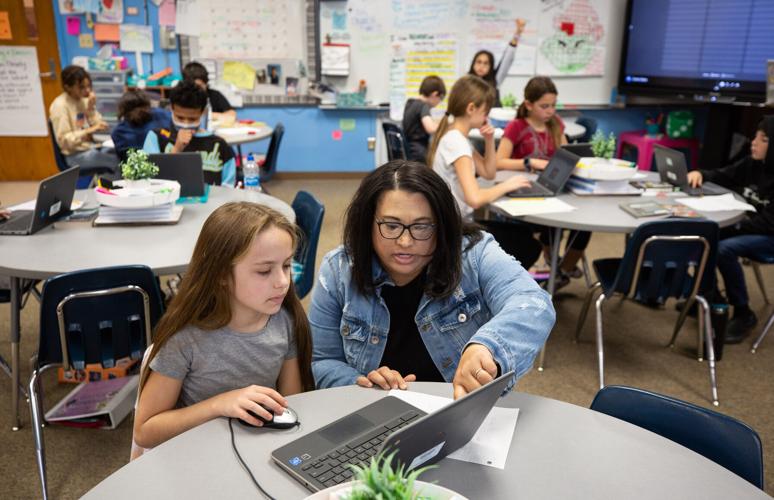Tucson Unified School District proposes adding a sixth-grade level to some of its elementary schools, converting them into K-6 schools, in time for the 2023-2024 school year.
If this first phase of a pilot program is approved by the governing board and successful, adding sixth grade to some other elementary schools might follow, Superintendent Gabriel Trujillo said.
The measure would start by converting these six elementary schools: Davidson and Whitmore on the northeast side of town, Steele and Soleng Tom on the east side, and Banks and Lynn-Urquides on the southwest.
The proposal discussed Tuesday by the board does not include changes to the affected middle schools, as administrators said that would require more time and expenses.
The six chosen schools are currently “feeders” for Gridley, Valencia, Doolen and Magee middle schools. Parents who don’t prefer the K-6 models would still have the option of enrolling their kids in middle school, said Bryant Nodine, TUSD’s operations program manager.
“The objective of this is two-pronged. We want to improve academic performance, particularly at the middle schools, and attract students from both inside and outside the district,” Nodine told the board.
District administrators are proposing the changes based on their research showing sixth-graders tend to perform better in K-8 schools, as well as survey results in which TUSD parents said they preferred the option of keeping their children in elementary schools for sixth grade.
Creating K-8 schools would be a much bigger project and isn’t contemplated for the district, Nodine said.
Nodine said the potential changes would help prepare students for the departmentalized instruction they will receive in middle and high schools, while they’re still in a familiar elementary school environment. Departmentalized instruction refers to different educators teaching specific subjects to various groups of students, as opposed to one educator teaching all subjects in one class.
The changes would also reduce the size of the district’s larger middle schools, allowing teachers to provide more personal attention to help students improve their academics and behavioral skills, he said.
The district noted in its proposal that “academically, and in terms of discipline, middle schools are the weakest school level.”
Ultimately, Nodine said, the conversion to K-6 schools would create a smoother transition to middle school, which could help avoid the reduction in enrollment numbers that is typically seen as students move from elementary to middle schools.
Nationally and locally, K-8 schools were long the norm until the widespread trend, which accelerated in the 1970s, of creating more middle schools with grades 6 through 8. “Seventy-five percent of sixth-graders nationwide now go to middle school. The tide may be turning again, however, in favor of returning sixth-graders to elementary school,” Public School Review reported on Nov. 30.
That report cited national research by Duke University saying sixth-graders in middle school have more behavioral problems than their peers in elementary school and that sixth-graders in elementary schools test higher than those in middle schools.

5th grade students in Chelsie Brown’s class work on the final draft of a narrative writing assignment on the Oregon Trail at Soleng Tom Elementary School, 10520 E. Camino Quince, Tucson, on Dec. 1.
Retaining students
The six TUSD schools were chosen based on certain criteria that included campus capacity in elementary schools, sizes of sixth-grade classes in middle schools, parental preference and areas where the district could improve its enrollment retention.
Nodine said the district’s analysis showed that, upon transitioning from elementary to middle school, students have often opted out of enrolling at their corresponding middle schools and have instead registered at nearby K-8 schools both inside and outside the district.
He said the proposed changes would provide similar education experiences as in the successful competitor schools.
The district conducted a survey in 2019 to gauge parental preference, and found that parents had a slight preference for bringing sixth grade to elementary schools. That survey was updated in November and results showed the same preference.
This year’s survey, so far, has had a 40% response rate among parents at the six chosen schools. Of those respondents, 81% said they plan to enroll their kids in a TUSD school for sixth grade regardless of changes.
That number increased to 91% of respondents who would enroll their kids in a TUSD school for sixth grade if their school is converted to a K-6.
Soleng Tom Elementary, in particular, showed the largest preference for the K-6 conversion, with 94% of parents who responded saying they would stay in the district if sixth grade is added to the school, as opposed to 70% who would stay with the district if the change isn’t made.
“I want to make a point here again, the objective of this is not just retention. The objective of this is to look at how we can improve academics, make a better transition into the middle schools and make schools more attractive for parents,” Nodine said.
Impacts
Ideally, Nodine said, the affected middle schools would have a sixth-grade model in which students have two or three separate classes for different subjects to ease them into the departmentalized instruction.
According to the district’s research, sixth graders in elementary schools “had more opportunities to be leaders and win successes, they felt safer, and they could be motivated for increased academic performance.”
Nodine said the district would also have to explore ways in which it could offer sports and clubs for sixth-graders in K-6 schools. He said district policy currently doesn’t allow for sixth-graders to participate in K-5 sports, but the district could look into partnerships with local clubs.
And as far as teachers, he said some middle schools, such as Gridley, have an excess of staff relative to their enrollment numbers, so the district could transfer those positions to the newly-formed K-6 schools.
But the district would still have to hire more teachers and staff for other schools, such as Whitmore and Davidson. The estimated costs for that would be about $432,000.
One tradeoff, Nodine said, might be that sixth graders in elementary schools may not have the same opportunities for labs and electives as those in middle school.
Adjusting to middle school
Board member Adelita Grijalva said she likes the idea of the K-6 conversion for those schools, noting that she’s spoken with other parents who have particularly chosen the smaller middle schools within the district.
She added that she attended Wakefield Middle School when it only had seventh and eighth grades.
“I wish I could say that we changed the great reconfiguration for some really strong academic reason, but it was literally because our elementary schools were very full, so we moved sixth into middle schools,” Grijalva said.
Board member Sadie Shaw said she’s aware of many parents in favor of adding a sixth grade to the selected schools. But, she said, the district needs to narrow down how it will help the sixth-graders in elementary schools transition to traditional middle schools.
“I worry about the transition, and so for this pilot program to be successful, I feel like we have to not only revise some of the schools to be K-6 but we should also choose one or two middle schools to be seventh through eighth grade schools,” she said.
Trujillo said the district has already formed a committee to find the best practices for ensuring successful K-6 conversions, as well as smooth transitions to the middle schools.
“We know that we just can’t have sixth grade be the same. It just can’t be another year of fifth grade,” Trujillo said.






